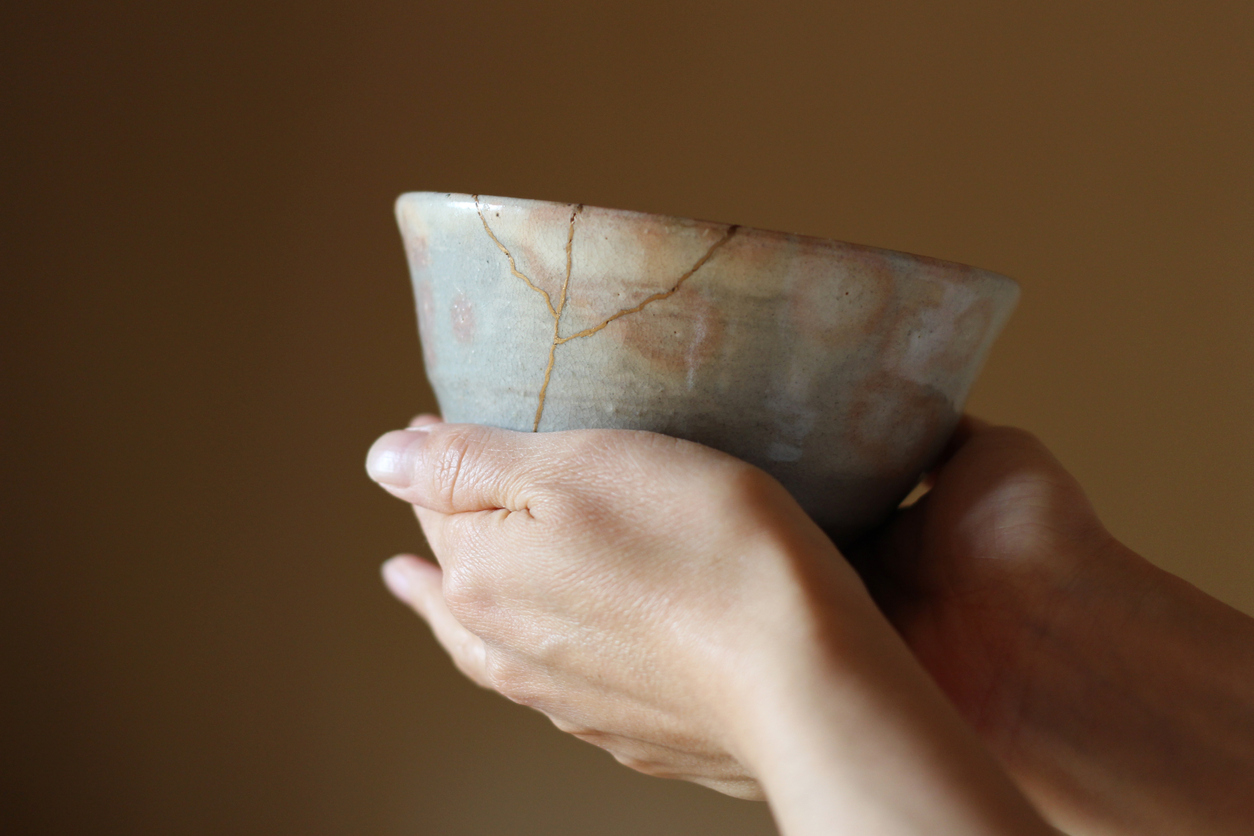
A new logo for our intensive counseling center
We are delighted to announce our new logo in 2024 as a symbol of the journey we invite soul care participants into. This logo is designed to embody our unique mission.
The image features a piece of pottery that has been broken and remade, inspired by one of our favorite concepts — kintsugi.
What is the meaning of kintsugi and how does it relate to mental health?
Kintsugi, meaning “golden joint” or “golden repair,” is a Japanese method lacquer masters use to remake broken teaware. The lacquer seals the pieces back together, then gold powder accentuates the cracks between pieces rather than hiding them. Tea families would even keep fragments for generations, seeking a master who could put them together into something more beautiful than before. It is a challenging and meditative craft.
What we love about this practice is its emphasis on maintaining the fragmentation. Or as we like to call it in our line of work, the wounds. Kintsugi considers how something that was broken, no matter how badly, can be put together into a creation that is even stronger and more striking.
What does kintsugi mean for Restoring the Soul’s mission and approach to healing trauma?
When we experience trauma, it can be life-altering, earth-shattering to our rhythms, relationships, and sense of self. It breaks us into pieces, and we become discouraged. We may have little vision for how to put them back together. How could we ever seal and cover up the seams so that we are whole again?
There is no easy answer to that question. But at Restoring the Soul, we believe that healing and restoration are about becoming a new creation, rather than covering up our scars. Kintsugi masters may spend a long time simply beholding the broken pieces before they begin gluing fragments together. They want to see the whole picture, how the lines will wind through the pieces to bring unity.
We seek to do the same thing with the participants we meet in the intensive therapy room. By making room for your wounds and acknowledging them, we hope to help you see yourself as capable of a healing that brings you back together and moves you forward into who you are meant to be.
How kintsugi reflects Jesus
This idea of “new creation” is also central to Restoring the Soul’s mission because it reflects Jesus’ journey on the cross and post-resurrection appearance. He chose to be a wounded human, appearing to his disciples with nail marks in his hands still showing. As Isaiah 53:5 says, “By his wounds we are healed.” His wounds created a path to restoration for us, no matter how shattered we are. Through Jesus, we are kintsugi pieces, new creations: ourselves, but even more beautiful than before.
Jesus accepts and loves us with all our flaws, imperfections, and painful experiences. He offers you an opportunity to be created anew, filled with rivers of gold — to be as valuable to yourself as you are to God.

What does this mean for intensive counseling?
One of the main things we focus on during the intensive is unresolved trauma. In other words, where and why do you feel like you’ve fallen into pieces? We understand that this can be a challenging experience as you enter into a vulnerable space that may be scary or even startling. The good news is, as we’ve explored through kintsugi, there is more to you than this pain.
As professional and licensed therapists, we promise to see and treat you as more than a victim of what happened to you. You will not be powerless in the room with us, even if you revisit moments where you felt powerless previously. Your time in intensive counseling is about helping you own your journey to restoration so that you can live in the present rather than being stuck in the past. This is central to our work — we help you get unstuck.
If all of this feels impossible right now, that’s okay. Ultimately, to heal from trauma we must be able to say, “Things could be different.” That’s why we remind you of the kintsugi artist, admiring the fragments and spending time cultivating imagination. The artist must work slowly, considering different angles and possibilities. The act of remaking involves curiosity and gentleness to shape a vision for the future. It takes time and baby steps. We’re here to help you work toward hope.
We’re glad you’re here.
Whether you’re considering a counseling intensive or simply interested in what we do at Restoring the Soul, we’re excited to share our vision for restoration with you. We hope that this imagery will reassure you that you are safe here, no matter what.
Interested in learning more about kintsugi? Check out our podcast episode with our friends Mako & Haejin Shim Fujimura, “Kintsugi Reflects Life” to hear about art, trauma, and kintsugi — or explore the Kintsugi Academy, where Haejin serves as president.
Listen to conversations with our therapists and experts in the field of change and restoration on the Restoring the Soul Podcast with Michael John Cusick.